Baslow - a charming Derbyshire village
Derbyshire was my home county until my family moved to Wiltshire in 1971. When heading into the Peak District National Park, invariably, we would pass through the village of Baslow. I have a fondness for Baslow and enjoy visiting. We stayed at an Airbnb in the village for a few days a couple of years ago. This made a pleasant break and the opportunity to enjoy a lovely meal at Charlie’s, one of the many good places to eat that Baslow offers.
In this article, though, I will take you along with me, my wife, Annette and my grandson, Albie (age 2¾), when we visited in August 2023.
Baslow comprises four areas: Bubnell, west of the River Derwent; Bridge End, which is by the river crossing; Over End, east of Bubnell and where most homes are concentrated. Finally, Nether End, which is close to Chatsworth Park and a good place to park your car for walks in the park. Nether End almost seems like a separate village when you travel through Baslow, and it’s here that we park in the public car park to explore the village.
Albie loves to walk and ditched the pushchair (stroller US) ages ago. He usually pushed it rather than sat in it, so it soon became redundant. I intended to walk only some streets in the village, just a few key areas, to be able to take some photographs to show you. We can’t wear the little man out!
Nether End has a lovely triangular green where a busy bus stop is conveniently placed for walkers and others to enjoy Baslow and Chatsworth Park. I mentioned at the outset that there are plenty of places to eat and get refreshments, and this part of Baslow has many. The Cafe on the Green is a fine example, and next door is the Devonshire Arms. To give you even more choice, opposite The Green is an Italian restaurant, il Lupo (The Wolf - thanks, Google!). If the road is busy, and it often is, use the pedestrian crossing by this restaurant. A short walk from the Green going out of the village is The Wheatsheaf Hotel, offering good food and accommodation.
Click on any image in this article to enlarge it.
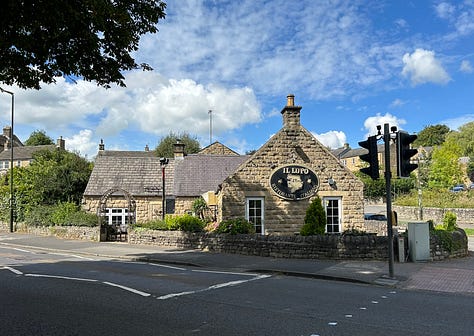
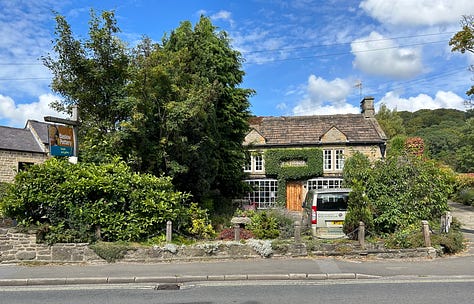

Leaving the car park (public toilets are here), we go past the sweet shop to show Albie the Bar Brook flowing nearby. The lovely buildings around The Green and alongside the river are of stone construction. This is not surprising as Derbyshire is rich in stone and well-known for its drystone walls. See the photographs below.



We now walk past the Cafe on The Green and The Devonshire Arms to take more photos and reach the main road, the A619, which today is very busy. There are a couple of shops on this side and a pottery and The Wheatsheaf Hotel opposite. For those ladies who like to wear designer clothes, Izzi of Baslow is just for you. I noticed a sign on the door saying you must knock and wait to enter. Sad, but I guess the owner is worried about theft. It would be easy on that main road to do a grab-and-dash raid.

Let’s now head off towards the crossing, firstly grabbing a photo of a Hulleys bus waiting for passengers at the stop. Hulleys are based in Baslow and have provided a bus service since 1914. As soon as we cross the road by Il Lupo and head up the hill, we can see yet another hotel on the opposite side of the road, The Cavendish Hotel.
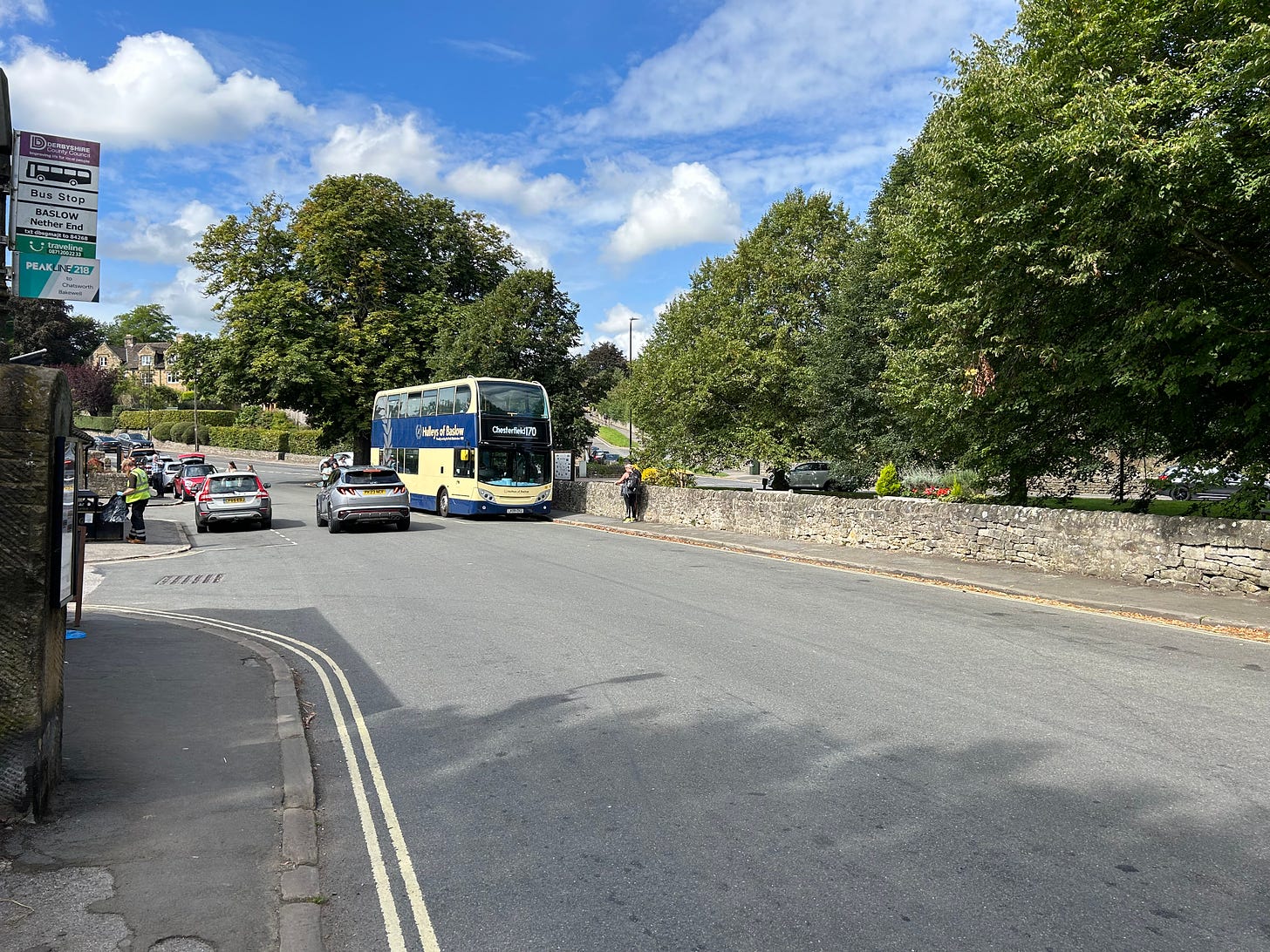
After a climb, we reach the brow of the hill and head down towards the original settlement of Baslow, which lies around the church. The land opens up, and the Chatsworth Park Caravan and Motorhome Club Campsite entrance and the sports field are on our left. The sign clearly says ‘No Tents”. Sorry, tent people - you need to live in something with wheels!
Crossing the large roundabout onto Calver Road, we now leave behind some of the heavy traffic that flows over a bridge on its way towards Bakewell. It’s in this area around the church that the population of Baslow grew. It’s still not huge. In 2011, it was 1178 persons, and it won’t be many more now. We first pass The Prince of Wales. I’m sorry, but the list of pubs and restaurants is not yet finished. Honestly, you could live in Baslow and never get bored with the choice of places to eat. A few shops are here, including a beauty salon at the bottom of School Lane. The lane rises steeply into Over End, at the next mini-roundabout, where many houses are in Baslow. The Post Office is further along School Lane, built into a Spar shop.
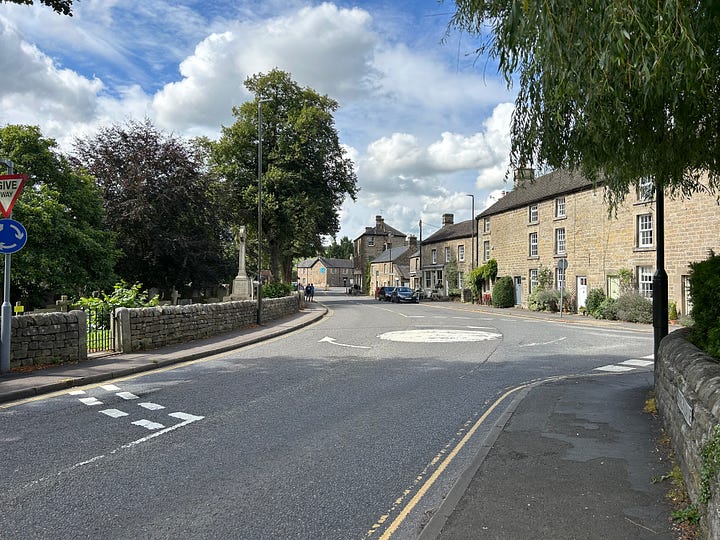
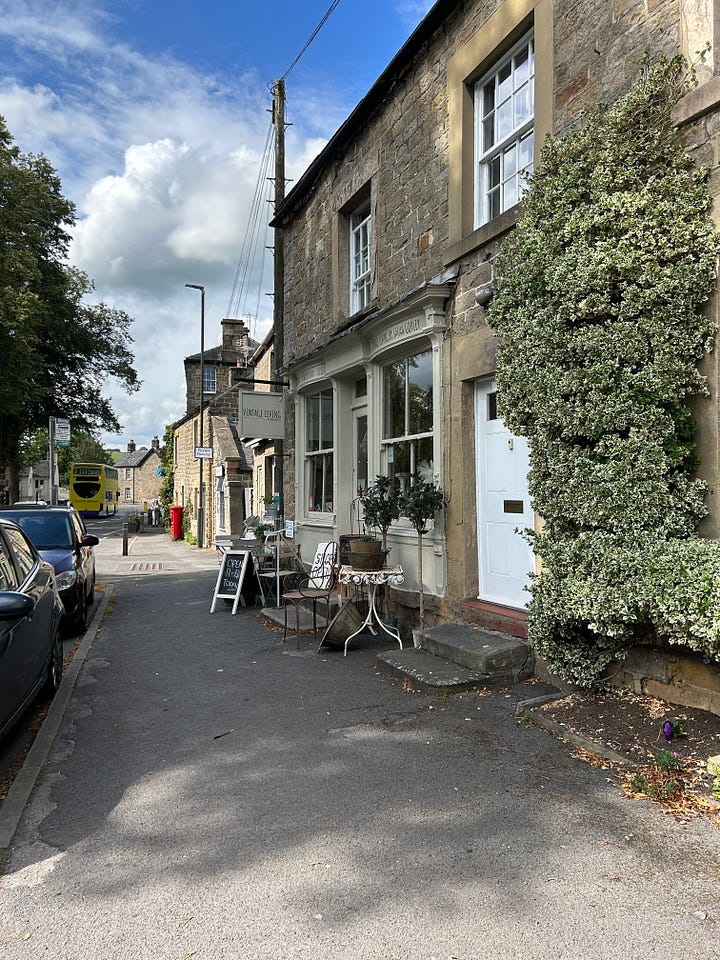


We walk on the opposite side of the road to the church and will return to it later. Albie is loving the walk and taking in the surroundings. Passing Charlie's Restaurant, we pop into the shop next door, The Chicken Shed (interesting name). It sells very lovely gifts, flowers and furniture. I don’t think there is a website, but here is the link to the Instagram account. I will add a few photos below of the shop; I think the owner does a great job displaying her goods and making it a welcoming business. Whilst Annette chats to the owner, I keep Albie entertained. He’s very good and doesn’t go around picking things up and causing havoc, although he has in the past when with his mum!






Leaving The Chicken Shed, we cross the road and pick up a few snacks from the Co-op to munch on a little while later. Albie likes Mr Kipling’s Bakewell Slices. What is reportedly the oldest bridge across the River Derwent is here. The date it was opened is 1603, and amazingly, that was 420 years ago. It’s said to be the oldest bridge crossing the river, and I can well believe that. The bridge takes traffic over the River Derwent into the area known as Bubnell. There is a toll house of the period, as you can see in the photos. Maybe I should stand here and collect money. Do you think I would get away with doing that? Or perhaps give my Buy Me a Coffee link to passersby to raise funds for Bakewell Slices for Albie! Floods have never destroyed this bridge as they have many others have along the River Derwent—a testimony to its designer and builder.
The river provided power for the flour mill just up the river. The mill’s weir can be seen from the bridge. The Old Mill is now a home offering B&B for visitors and has good online reviews. Looking over the parapet, it’s clear that the River Derwent is relatively shallow at this point as it flows and babbles over the rocky riverbed.




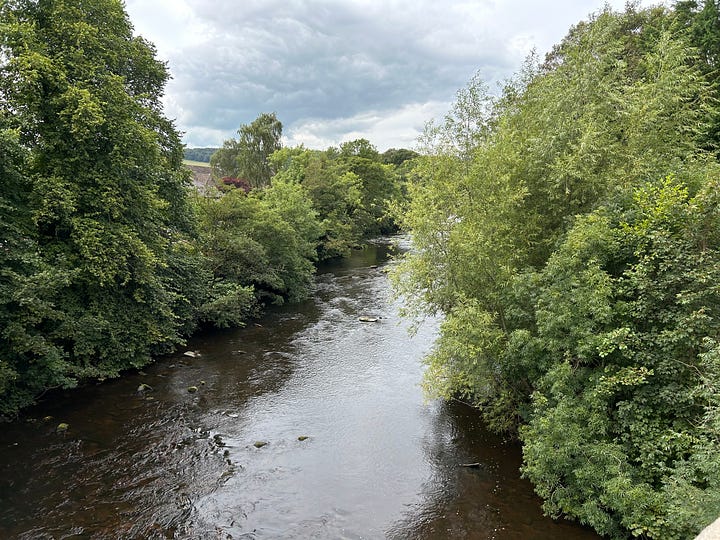
We now head towards the church and discover a path alongside it that leads to the riverbank and a seat. Perfect! Now, we can enjoy Mr. Kipling’s Bakewell Slices, much to Albie’s delight. A small flotilla of ducks is waiting for crumbs. Yes, those stuck on Albie’s face!
The church is St Anne’s. A Saxon coffin lid is in the porch entrance, perhaps indicating that there was once a Saxon church on this site, as with many old churches. This church isn’t Saxon and dates from the 12th century, the oldest part being the north aisle. The tower is 13th century, and the rest has been subject to restoration in 1852, 1894 and 1911 (chancel rebuilt).
The clock in the tower is interesting. On the east face, the clock is inscribed with the characters VICTORIA1897, the year of Queen Victoria’s diamond jubilee. Please zoom in on photo 2 to see the wording on the clock. The clock was a gift to celebrate that event and was gifted by Dr. Edward Mason Wrench.
The oldest bell in the tower dates back over five hundred years to 1520. The church is known for having a whip formerly used by the parish Dog whipper. Call the RSPCA! How times have changed regarding animals, although in some ways not so much for people.



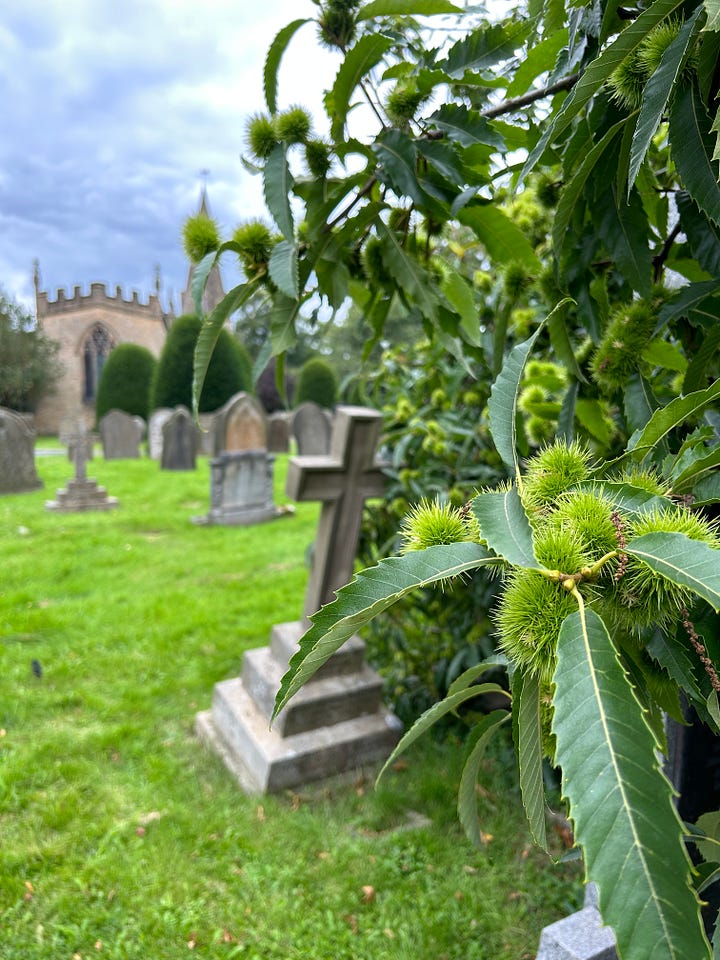
We now head back on a steady walk towards the car park. Before I leave you, let me share a few other things. Had we walked further on, we would have come to the entrance to Fischer’s Hall. It appears to be a rather plush place to stay and eat. On their website, there are offers for a couple to stay for two nights with meals, the first night a full-on menu and a lighter plate the following evening—cost from £640. I may need to start a GoFundMe page if you want me to try it out and write about it in Roland’s Travels!
The building was once Baslow Hall, built in 1907. By 1913, the house had been purchased by Sebastian Ziani de Ferranti, the radio and electrical pioneer and inventor. It was also once owned by George Kenning, who grew his business to become a national car dealership in the UK.
There was once a hydro in Baslow; now, the only trace is in the name of Hydro Close, upon which some rather lovely houses have been built on its site. Opened in 1881, it was The Grand Hotel and Hydro, and it remained in use until 1930. It was a very imposing building, and a few photos are online. The hotel had 120 rooms, a ballroom and massage rooms. Here’s a more detailed description of the hotel if you want to know more.
A buyer couldn’t be found, and so it went to auction. A developer purchased it, and the contents were auctioned in 1936 and demolished for the current homes to be built. A couple of gate posts are all that remain, and one of the artefacts, an ornamental fountain, is in the garden of one of the houses in the close.
Records show that from 1896 to the 1930s, a nine-hole golf course was also connected to the Baslow Grand Hotel. Now gone without a trace. Baslow certainly has a great deal of history, and it would take many more articles to cover part of it. Maybe in the future, I will return to follow up on some of the stories my research has uncovered! Let me know if you want to know more about this charming Derbyshire village.
Anyway, we are back at the car and just in time. The rain has started to fall - again! August in England has been abysmal. I am writing this in September, fan on and still melting with record-high temperatures. You can’t make this stuff up!
I certainly enjoyed my visit and hope you enjoyed this shared experience. Please consider referring a friend to Roland’s Travels. You can earn yourself some paid subscriber months.









Re- Izzi fashion designer---perhaps you have knock and wait to enter because there is a client trying on clothes, nothing to be with being afraid of a robbery!!!